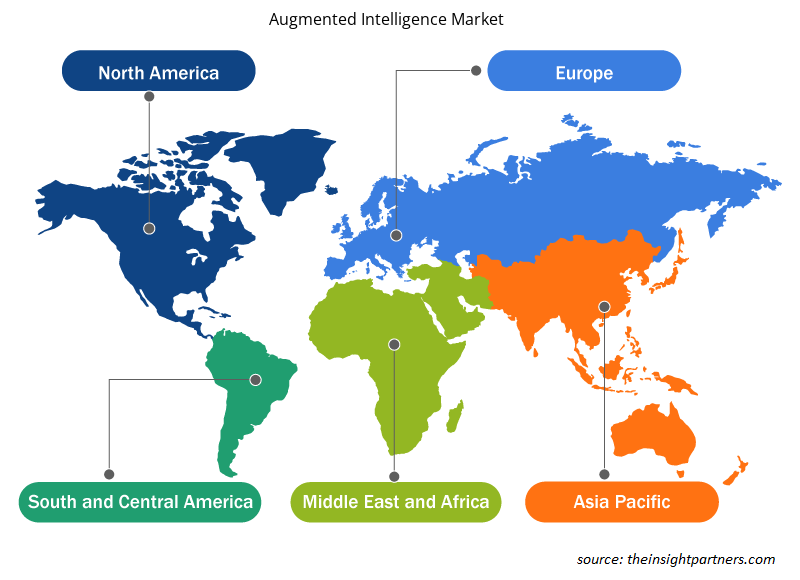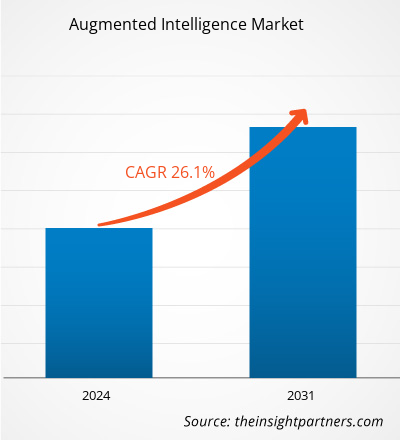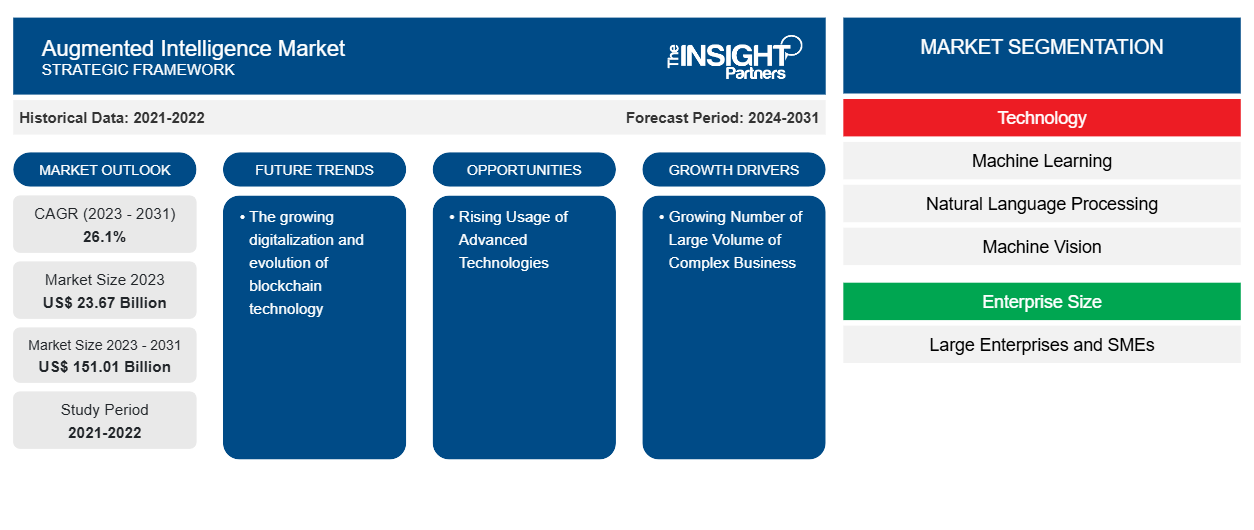拡張インテリジェンス市場規模は、2023年の236億7,000万米ドルから2031年には1,510億1,000万米ドルに達すると予測されています。市場は2023年から2031年にかけて26.1%のCAGRを記録すると予想されています。デジタル化の進展とブロックチェーン技術の進化は、拡張インテリジェンス市場の重要なトレンドであり続けると思われます。
拡張知能市場分析
拡張インテリジェンス市場は、大量の複雑なビジネス データの増加と、BFSI、IT および通信、小売および電子商取引業界の拡大により、急速に成長しています。市場は、中小企業における拡張インテリジェンスの採用の増加に牽引されて着実に拡大しています。さらに、企業における高度なテクノロジーの使用の増加とクラウドベースのソリューションの採用の増加は、市場の成長にとって有利な機会を提供しています。
拡張知能市場の概要
拡張インテリジェンスは、AI の補助機能に重点を置いた人工知能の一種です。さらに、拡張インテリジェンスは、組織がビジネスや日常生活でより正確なデータ主導の意思決定を行えるようにサポートするために作成されています。さらに、拡張インテリジェンスは、企業が従業員のパフォーマンスを向上させるために使用され、組織が従業員の改善領域を理解するのに役立ち、市場を牽引しています。さらに、拡張インテリジェンスは、企業に予測分析を提供することで、大量のセキュリティ データを使用して優先順位を付ける最も効果的な手法です。
要件に合わせてレポートをカスタマイズする
このレポートの一部、国レベルの分析、Excelデータパックなど、あらゆるレポートを無料でカスタマイズできます。また、スタートアップや大学向けのお得なオファーや割引もご利用いただけます。
- このレポートの主要な市場動向を入手してください。この無料サンプルには、市場動向から見積もりや予測に至るまでのデータ分析が含まれます。
拡張知能市場の推進要因と機会
大量の複雑なビジネスデータの増加が市場を牽引
機械学習や自然言語処理などの拡張インテリジェンス技術は、データ分析においてますます重要になっています。拡張インテリジェンスにより、企業内に保存されている組織化されたデータ ソース、半構造化データ ソース、非構造化データ ソースの分析が可能になります。今後数年間、業界の拡大や企業運営全体にわたるデジタル テクノロジーの進化に伴い、作成されるデータの多様性と量が大幅に増加すると予測されています。これにより、大量のデータを効果的かつ効率的に管理するための拡張インテリジェンス ソリューションに対する企業の需要が高まります。ただし、予測期間中、複雑なデータの量の増加により、拡張インテリジェンス市場が活性化すると予測されています。
先進技術の利用増加 – 拡張知能市場におけるチャンス
人工知能、機械学習、自然言語処理技術などの高度な技術の使用の増加により、予測期間中に市場成長の機会が生まれています。ITおよび通信、小売および電子商取引、BFSI、ヘルスケアなどの多くの業界では、膨大な量のデータが生成されており、このデータをリアルタイムで分析するための高度な技術が必要であり、拡張インテリジェンスソリューションの需要が高まっています。業界では、リアルタイムで効果的な意思決定を行うことで膨大なデータを分析するために、人工知能、機械学習、自然言語処理などの新しい技術を採用しています。これらのツールにより、データから洞察を抽出するプロセスが簡素化され、その採用が増加し、市場に機会が生まれています。
拡張知能市場レポートのセグメンテーション分析
拡張インテリジェンス市場分析の導出に貢献した主なセグメントは、テクノロジー、企業規模、エンドユーザーである。
- 技術に基づいて、拡張インテリジェンス市場は、機械学習、自然言語処理、マシンビジョン、コンテキスト認識コンピューティングなどに分かれています。機械学習セグメントは、2023年に大きな市場シェアを占めました。
- 企業規模別に見ると、市場は大企業と中小企業に分かれており、2023年には中小企業セグメントがより大きな市場シェアを占めました。
- エンドユーザーの観点から見ると、市場はITおよび通信、小売および電子商取引、BFSI、ヘルスケア、その他に分類されています。BFSIセグメントは2023年に大きな市場シェアを占めました。
地域別拡張知能市場シェア分析
拡張インテリジェンス市場レポートの地理的範囲は、主に北米、アジア太平洋、ヨーロッパ、中東およびアフリカ、南米/中南米の 5 つの地域に分かれています。
収益面では、北米が、IBM Corporation、Microsoft Corporation、TIBCO Software Inc.、Salesforce.com、Inc.、MicroStrategy Incorporatedなどの技術の進歩と主要企業の存在により、拡張インテリジェンス市場で最大のシェアを占めています。これらの企業は、AI、ML、NLPなどの高度な技術の採用に多額の投資を行っており、追加機能を追加することでこれらの技術の開発に継続的に取り組んでいます。ITおよび通信、BFSI、小売および電子商取引、ヘルスケアなどの業界におけるクラウドベースの拡張インテリジェンスの需要の高まりにより、北米の市場が拡大すると予測されています。
拡張知能市場の地域別インサイト
予測期間を通じて拡張インテリジェンス市場に影響を与える地域的な傾向と要因は、Insight Partners のアナリストによって徹底的に説明されています。このセクションでは、北米、ヨーロッパ、アジア太平洋、中東およびアフリカ、南米および中米にわたる拡張インテリジェンス市場のセグメントと地理についても説明します。

- 拡張インテリジェンス市場の地域別データを入手
拡張知能市場レポートの範囲
| レポート属性 | 詳細 |
|---|---|
| 2023年の市場規模 | 236.7億米ドル |
| 2031年までの市場規模 | 1,510.1億米ドル |
| 世界のCAGR(2023年~2031年) | 26.1% |
| 履歴データ | 2021-2022 |
| 予測期間 | 2024-2031 |
| 対象セグメント | テクノロジー別
|
| 対象地域と国 | 北米
|
| 市場リーダーと主要企業プロフィール |
|
拡張知能市場のプレーヤー密度: ビジネスダイナミクスへの影響を理解する
拡張インテリジェンス市場は、消費者の嗜好の変化、技術の進歩、製品の利点に対する認識の高まりなどの要因により、エンドユーザーの需要が高まり、急速に成長しています。需要が高まるにつれて、企業は提供を拡大し、消費者のニーズを満たすために革新し、新たなトレンドを活用し、市場の成長をさらに促進しています。
市場プレーヤー密度とは、特定の市場または業界内で活動している企業または会社の分布を指します。これは、特定の市場スペースに、その規模または総市場価値と比較して、どれだけの競合相手 (市場プレーヤー) が存在するかを示します。
拡張インテリジェンス市場で事業を展開している主要企業は次のとおりです。
- IBMコーポレーション
- マイクロソフト株式会社
- SAP SE
- TIBCO ソフトウェア株式会社
- 株式会社シセンス
- セールスフォース・ドットコム株式会社
免責事項:上記の企業は、特定の順序でランク付けされていません。

- 拡張知能市場のトップキープレーヤーの概要を入手
拡張知能市場のニュースと最近の動向
拡張インテリジェンス市場は、主要な企業出版物、協会データ、データベースなど、一次調査と二次調査後の定性的および定量的データを収集することで評価されます。以下は、拡張インテリジェンス市場と戦略の動向の一覧です。
- 2023 年 9 月、オラクル社は本日、Oracle Analytics Cloud 内で AI を活用した新機能を発表しました。生成 AI アシスタントや拡張分析などの新しいセルフサービス AI 機能は、組織がデータによる意思決定への影響を改善するのに役立ちます。(出典: オラクル社、プレスリリース、2023 年)
拡張知能市場レポートの対象範囲と成果物
「拡張インテリジェンス市場の規模と予測(2021〜2031年)」レポートでは、以下の分野をカバーする市場の詳細な分析を提供しています。
- 対象範囲に含まれるすべての主要市場セグメントの世界、地域、国レベルでの市場規模と予測
- 市場の動向(推進要因、制約、主要な機会など)
- 今後の主な動向
- 詳細なPEST/ポーターの5つの力とSWOT分析
- 主要な市場動向、主要プレーヤー、規制、最近の市場動向を網羅した世界および地域の市場分析
- 市場集中、ヒートマップ分析、主要プレーヤー、最近の動向を網羅した業界の状況と競争分析
- 詳細な企業プロフィール
- 過去2年間の分析、基準年、CAGRによる予測(7年間)
- PEST分析とSWOT分析
- 市場規模価値/数量 - 世界、地域、国
- 業界と競争環境
- Excel データセット
最新レポート
お客様の声
購入理由
- 情報に基づいた意思決定
- 市場動向の理解
- 競合分析
- 顧客インサイト
- 市場予測
- リスク軽減
- 戦略計画
- 投資の正当性
- 新興市場の特定
- マーケティング戦略の強化
- 業務効率の向上
- 規制動向への対応























 無料サンプルを入手 - 拡張知能市場
無料サンプルを入手 - 拡張知能市場